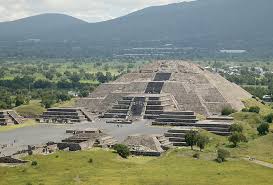 |
| San Miguel de Allende, Mexico |
In my travels throughout Mexico and Guatemala, I have been witness to the miracles of stone that were the pyramids of the ancient Mayan and Aztec civilizations. All of Meso-America,the area once inhabited by Mayans and Aztecs, is an archeological zone. Dig anywhere and you will find artefacts of the lost civilizations that once dominated the North American continent. Close to my home in San Miguel, for example is the pyramid of La Cañada de la Virgen.
 |
| La Cañada de la Virgen |
This small pyramid was recently discovered about 15 years ago. A German couple bought a sizeable piece of land in the desert surrounding San Miguel. They noticed some mounds on the property and did a bit of excavation. What they found astounded them. They brought their findings to the attention of the Mexican government, who expropriated the land as a National Treasure. The litigation went on for some time. After 4 or 5 years of archeological excavations they cleaned up the site, did a bit of restoration and opened the La Cañada pyramid for tourism.
It was built somewhere before the 10th century, maybe as early as 500 B.C. It was abandoned somewhere in the 11th Century. Carbon dating was used on the burial grounds where human remains where interred, so these dates are pretty accurate. Of course, Mexican pyramids are nothing new. The biggest is probably in Teotihuacan.
 |
Pyramid of the Sun, Teotihuacan, Mexico
|
And there are many such examples throughout the region. They all share certain characteristics: They were built between the 8th and 14th Centuries, were used for astronomical observations, were involved in the worship of the Sun, share a certain architecture nomenclature, and were used in religious ceremonies and rituals. One of the prominent themes in the stone carvings is that of the serpent, the snake, and the plumed serpent, or snake-bird Quetzalcoatl. The archeology of ancient Mexico is well understood and documented along rigorous 21st Century academic lines. Now let´s look at Angkor.
 |
| Cambodian Pyramid at Koh Ker, 62 km NE of Angkor |
The pyramids of Angkor were built between the 9th and 11th centuries, were used as observatories to calculate the positions of the stars, and follow a very similar architectural nomenclature. This is a stepped pyramid, similar to the ones found in Mexico.
 |
| Mexican Pyramid |
If you look at these photos in an album of pyramid photos, it is practically impossible to tell them apart. Not only do they share architectural characteristics and functions, the statuary of the Khmer pyramids also use the motifs of snake-birds and serpents. The Khmer carvings ha, ve a far more sophisticated mythology: The snakes are Nagas, and their cousin the Man-bird is Garuda, following the legends of the ancient Indian Puranas. But the parallels are obvious.
 |
| Koh Ker, Cambodia |
.jpg) |
| Koh Ker, another view |
 |
| Pyramids at Palenque, Mexico |
Curiously, while the pyramids of the Khmer Empire date back over a thousand years, the archeological studies done there are not up to the standard set in the investigations of Mexican ruins. This is because, while American and Mexican archeologists and their students have done exhaustive work at the known sites for more than a century, conflict, colonialism, and war have retarded similar efforts in Cambodia. Here's a very scholarly view of how these civilizations could have been related.
https://www.youtube.com/watch?v=hBB__YXYpOc
The natural question raised by anyone who has seen both the pyramids in Mexico and the pyramids in Cambodia is, "How are they related?" This is one of the questions our trip means to probe.
What are the parallels between these ancient civilizations? If any communication took place between these ancient peoples, then what was the nature of their cultural diffusion and integration. These are some of the ideas I'm interested in exploring in our adventure to Angkor. Stay tuned.





.jpg)

No comments:
Post a Comment
Note: Only a member of this blog may post a comment.